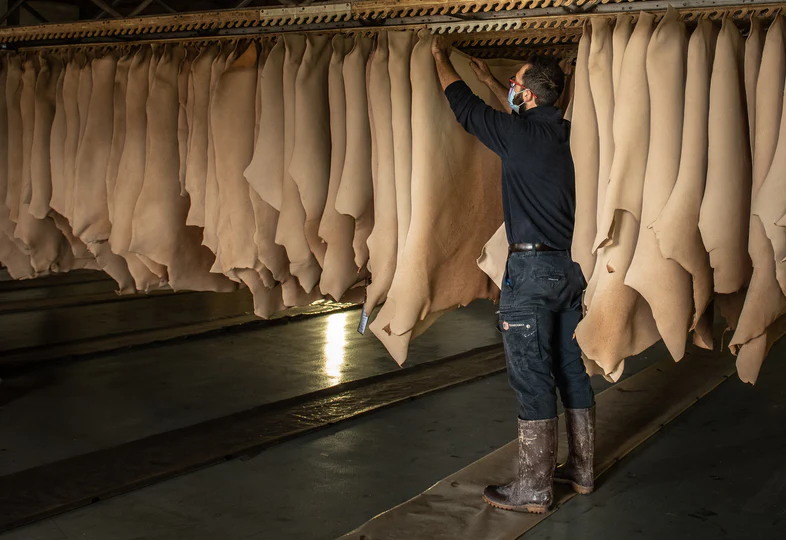Introduction: The Epitome of Leather Craftsmanship
In the realm of leather goods, full-grain leather stands as the pinnacle of quality and craftsmanship. Renowned for its durability, natural beauty, and the one-of-a-kind patina it develops with age, full-grain leather is the material of choice for those who demand excellence.
This in-depth guide unpacks everything you need to know about full-grain leather: what it is, how it’s made, why it’s better, how to care for it, and how it compares to other types. Whether you’re a designer, buyer, or simply a curious enthusiast, you’re in the right place.
What Is Full-Grain Leather?
Full-grain leather is the topmost layer of an animal hide, including all of the grain with minimal processing. It’s not sanded or buffed to remove imperfections—those marks are preserved as part of its unique character.
Over time, this leather develops a patina—a deep, rich sheen that adds personality and value to each piece.
Key Characteristics of Full-Grain Leather
- Unaltered surface grain – Shows natural marks, veins, and patterns.
- Superior strength – The dense fiber structure ensures durability.
- Natural breathability – Keeps products comfortable to wear or use.
- Aging beautifully – Forms a patina unique to each item.
Unlike lower grades, full-grain leather is not “corrected” with heavy dyes, embossing, or plastic coatings. What you get is raw, rugged, and incredibly refined.
How Full-Grain Leather Is Made
Producing full-grain leather is a time-intensive, skilled process. The goal is to preserve the strength and surface beauty of the hide.
Step 1: Selecting Premium Hides
Not all hides qualify for full-grain leather. Only the best—usually from the shoulders and back—are chosen. These areas are tighter-grained and less likely to stretch or scar.
Step 2: Cleaning and Soaking
The hides are soaked in large vats to remove dirt and salts used during preservation.
Step 3: Liming and Unhairing
This step loosens hair and epidermis through an alkaline solution. It also swells the hide to open the fibers for tanning.
Step 4: Fleshing and Splitting
Excess flesh is removed from the back of the hide. In most full-grain processes, splitting is avoided to keep the hide intact.

Step 5: Tanning
Tanning stabilizes the collagen in the hide so it doesn’t decompose. Two main types of tanning are used:
- Vegetable tanning – A natural, eco-friendly method using tree bark tannins. Produces firm, richly colored leather that ages beautifully.
- Chrome tanning – A faster method using chromium salts. Produces softer leather, common in modern fashion.

Step 6: Drying and Conditioning
After tanning, the leather is dried (sometimes under vacuum) and conditioned to restore moisture.
Step 7: Finishing
Unlike corrected leather, finishing is kept minimal. A light oil or wax may be applied, but no artificial grain is embossed.
Why Full-Grain Leather Is the Best
Full-grain leather is not just a material—it’s a commitment to longevity and authenticity.
Strength and Longevity
Because it includes the full fiber structure, it resists tearing, cracking, and sagging far better than other leathers.
Unique Patina Over Time
Patina is the gradual darkening and softening of the leather through use, oils, and exposure to sunlight. No two items patina the same.
Timeless Appeal
It’s used by artisans and luxury brands alike to craft goods that are meant to be worn, used, and passed down.
Full-Grain Leather vs. Other Types
Here’s a breakdown of how full-grain leather compares to other grades:
| Leather Type | Surface | Durability | Breathability | Patina | Cost |
|---|---|---|---|---|---|
| Full-Grain | Natural | ★★★★★ | ★★★★★ | ★★★★★ | $$$$ |
| Top-Grain | Sanded | ★★★★☆ | ★★★★☆ | ★★★★☆ | $$$ |
| Genuine Leather | Heavily processed | ★★☆☆☆ | ★★☆☆☆ | ★☆☆☆ | $$ |
| Bonded Leather | Synthetic mix | ★☆☆☆☆ | ★☆☆☆☆ | ✕ | $ |
Common Uses of Full-Grain Leather
- Luxury handbags and accessories
- Belts, wallets, and cardholders
- Work boots and premium footwear
- Jackets and outerwear
- Furniture and car interiors
- Heritage goods and travel gear
Each product benefits from the strength, breathability, and natural beauty that only full-grain leather offers.
How to Spot Genuine Full-Grain Leather
Here are a few signs to look for:
- The surface feels textured and slightly uneven.
- Visible natural marks like wrinkles or pores.
- A rich smell—never plasticky.
- It darkens with use and exposure to air.
- The label may mention “top layer” or “full grain.”
Alt Text: “Macro shot of full-grain leather with visible skin texture and imperfections.”
How to Care for Full-Grain Leather
Proper maintenance ensures your leather ages gracefully and lasts decades.
Basic Cleaning
Wipe with a soft, dry cloth. For stains, use a leather-safe cleaner or slightly damp cloth—never saturate the leather.
Conditioning
Apply a natural leather conditioner every 4–6 months. It prevents drying and keeps the leather supple.
Storage
Keep away from heat, humidity, and direct sunlight. Use dust bags for items like shoes or bags.
Repairs
Scratches and scuffs usually blend over time. For deep damage, consult a leather specialist.
Sustainability and Ethical Sourcing
Full-grain leather, especially when vegetable-tanned, is more sustainable than synthetic alternatives. It’s biodegradable, long-lasting, and avoids microplastic pollution.
Look for suppliers or brands that:
- Use vegetable tanning
- Source hides from the food industry (byproducts)
- Follow ethical labor practices
Final Thoughts
If you’re looking for leather that truly lasts a lifetime, full-grain is the gold standard. It’s strong, beautiful, breathable, and only gets better with time.
From wallets to weekend bags, from jackets to luxury furniture, full-grain leather is a choice that reflects both style and substance.
